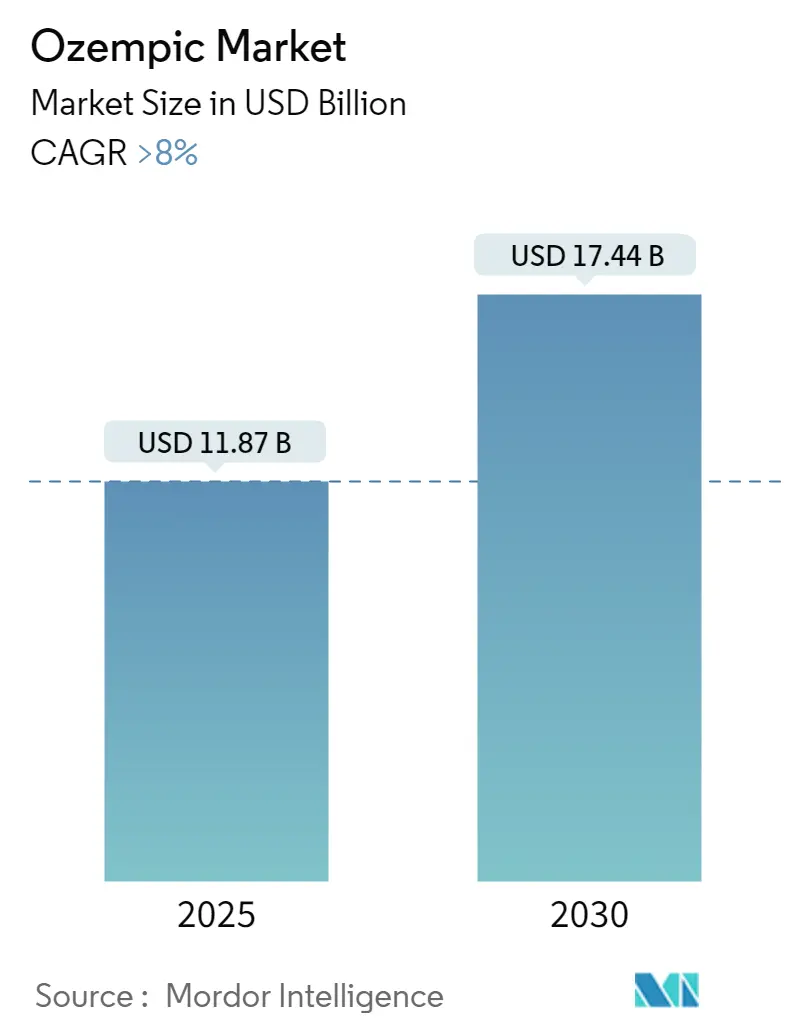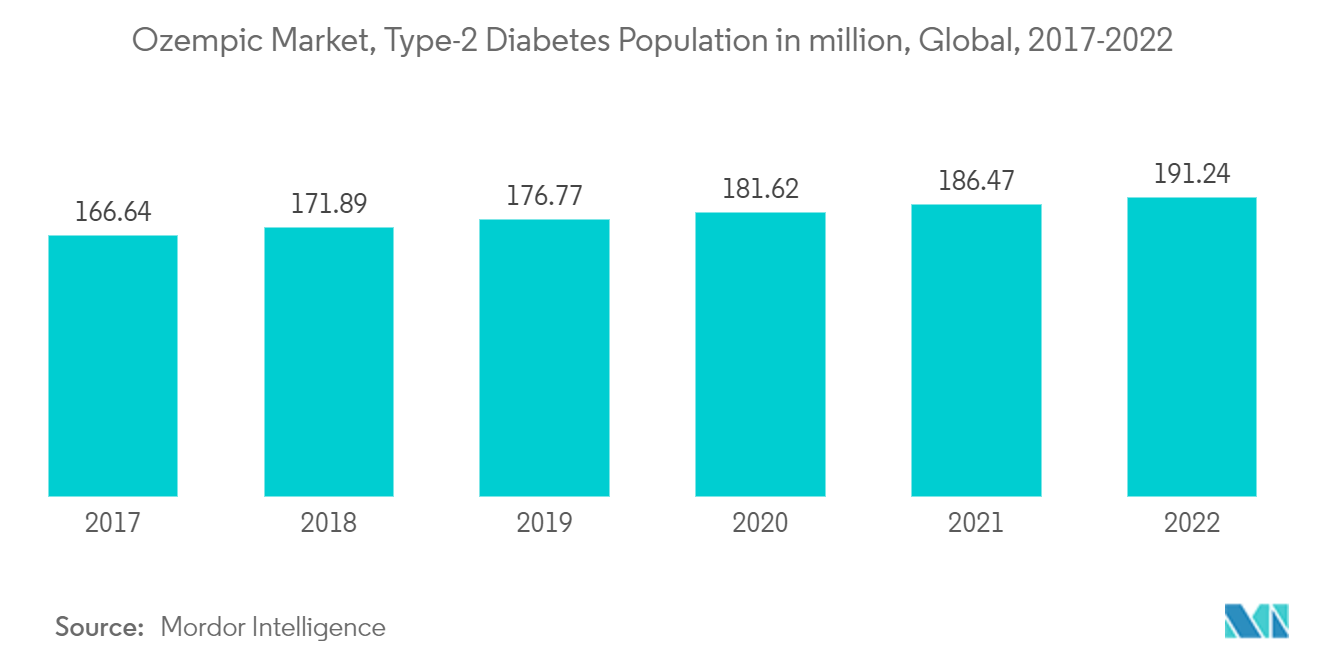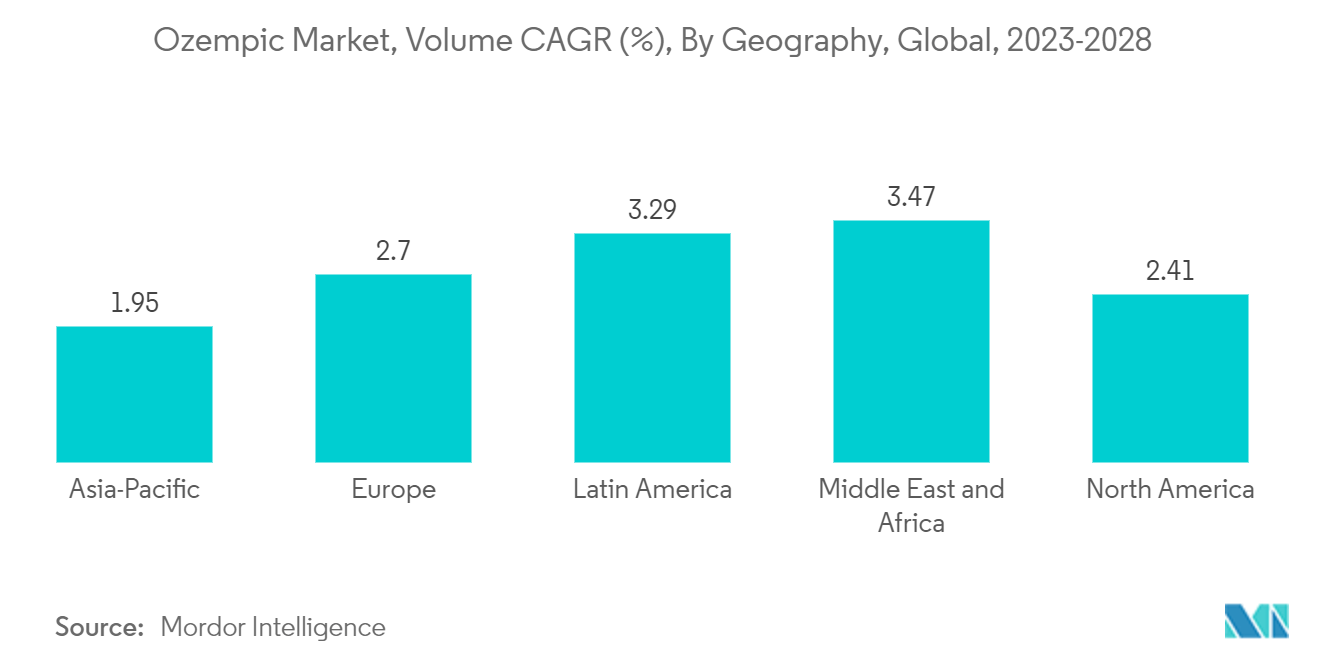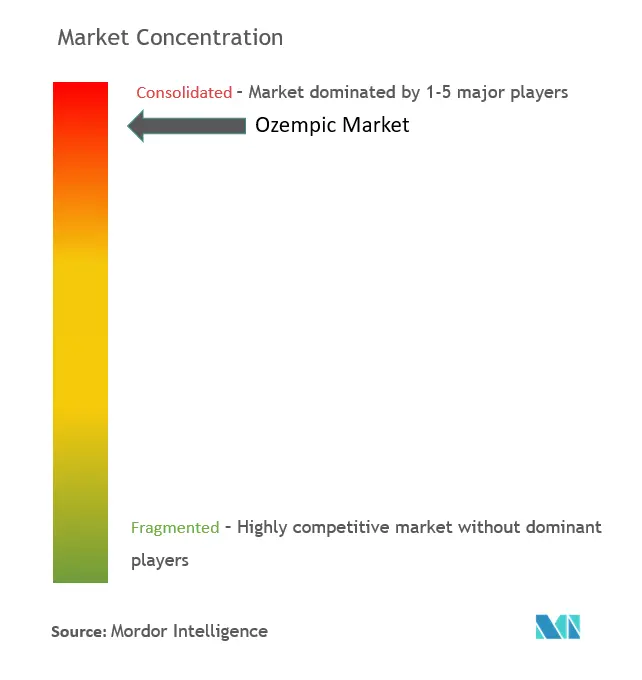Ozempic Market Analysis
The Ozempic Market size is estimated at USD 11.87 billion in 2025, and is expected to reach USD 17.44 billion by 2030, at a CAGR of greater than 8% during the forecast period (2025-2030).
During COVID-19, many governmental restrictions were imposed, putting people into lockdown, which led to a rise in obesogenic-prone behaviors. Further, the closure of fitness centers, stay-at-home policies, and increased unhealthy snacking were associated with sustained weight gain and persisted even after lockdown restrictions were lifted. Weight management guidelines recommended a multi-component approach for weight loss in patients living with obesity and overweight. The use of anti-obesity medications was a reliable and effective option for weight control to improve the quality of life and prevent the progression of weight-related comorbidities.
The Food and Drug Administration approved various anti-obesity medications for long-term use for individuals with BMI ≥30 kg/m2 or ≥ 27 kg/m2 with weight-related comorbidities, including Phentermine-topiramate, liraglutide, orlistat, naltrexone-bupropion, and semaglutide. Obesity is a major risk factor for several diseases, including diabetes, heart disease, and some cancers. In obese individuals, the fat cells in the body release pro-inflammatory chemicals, which may make the body less sensitive to the insulin it produces by disrupting the function of insulin-responsive cells. Furthermore, high blood sugar levels during the pandemic were significantly related to both morbidity and mortality. Thus, anti-obesity medications played a vital role in minimizing the risk of high blood glucose sugar levels during the pandemic.
Ozempic (semaglutide) injection is an injectable prescription medicine available in various strengths used along with diet and exercise to improve blood sugar in adults with type 2 diabetes to reduce the risk of major cardiovascular events such as heart attack or stroke in adults with type 2 diabetes with known heart disease. It belongs to a class of drugs called glucagon-like peptide-1 receptor agonists. It is a brand name and is currently not available in generic form. Ozempic comes as a liquid solution inside prefilled, disposable pens.
Major factors that are expected to boost the growth of the studied market in the forecast period are rising obesity and inactivity rates among people, which have resulted in an increase in the diabetes population over time, a rise in the sedentary lifestyle, improper dietary patterns, and the inherent history of diabetes disorders. In addition, rising investment in research and development, technological developments, and new product launches will further provide potential opportunities for the growth of glucagon-like peptide 1 (GLP-1) agonists such as ozempic in the coming years.
Ozempic Market Trends
Rising obesity and diabetes prevalence globally is likely to drive the market over forecast period
The diabetes population globally is expected to rise by 1.9% during the forecast period.
The major factors attributing to the growth of the market studied are an increase in obesity among people and a rising prevalence rate of Type 2 diabetes and heart diseases. People with more fat in their bodies are highly likely to be affected by diabetes. Hence, such patients are likely to take certain measures to prevent obesity with anti-obesity medications such as Ozempic. For instance, as per the World Obesity Atlas 2023, the estimates for global levels of overweight and obesity (BMI ≥25kg/m²) suggest that over 4 billion people may be affected by 2035. The prevalence of obesity (BMI ≥30kg/m²) alone is anticipated to rise to 24% of the population over the same period, affecting nearly 2 billion adults, children, and adolescents by 2035.
Additionally, according to the World Health Organization (WHO) May 2022 report on the European region, in the WHO European Region, over 60% of adults and 29% of boys and 27% of girls who are children are overweight or obese and also, as per the same report, overweight and obesity rank fourth among the risk factors for non-communicable diseases in the region, after high blood pressure, unhealthy eating, and cigarette use. Furthermore, according to the latest International Diabetes Federation report, it is estimated that the number of adults in the age group of 20-79 years across the world is projected to increase to 643 million by 2030. Hence, owing to the high burden of obesity and the increasing prevalence of risk factors for obesity are expected to fuel the market growth over the forecast period.
In 2022, the WHO Global Diabetes Compact outlined five diabetes targets to reach by 2030, focused on addressing metabolic risks, access to medication, and diagnosis. The outlook for a healthy future is further marked by sustained progress in strategies designed to remediate diabetes through control of calorie intake and physical activity or medication. Therefore, due to increased prevalence and the factors above, the studied market is anticipated to witness growth over the analysis period.
North America held the highest market share in the current year
The North American region held the highest market share in the current year.
In the North American region, the prevalence of diabetes has increased dramatically during the last two decades, a fact driven by the increased prevalence of obesity and lifestyle changes owing to less physical activity, unhealthy food habits, and other lifestyle factors.
The American Diabetes Association (ADA), the Endocrine Society, the American College of Physicians, the American Academy of Paediatrics, the Society of General Internal Medicine, and the National Academy of Medicine published statements and issued calls to action to address social determinants of health at the individual, organizational, and policy levels. ADA also published a scientific review describing the associations between SDOH and diabetes risk and outcomes, focusing on socioeconomic status, health literacy, the food environment, food insecurity, and neighborhood and physical environments, among other topics.
The Centers for Disease Control and Prevention (CDC) National Diabetes Statistics Report 2022 estimated that more than 130 million adults are living with diabetes or prediabetes in the United States. Type-2 diabetes is more common, and diabetes is more consequential among communities of color, those who live in rural areas, and those with less education, lower incomes, and lower health literacy.
Ozempic is not approved for weight loss specifically; the FDA greenlit them for type-2 diabetes. However, doctors commonly use this off-label for weight loss. Currently, Medicare does not cover anti-obesity drugs. However, the bipartisan Treat and Reduce Obesity Act introduced in Congress in the current year would expand Medicare Part D to provide coverage of approved medications for the treatment of obesity. If the bill is signed into law, it could open access to these drugs, not just for Medicare enrollees but also for people with other types of health insurance.
Therefore, the studied market is anticipated to grow over the analysis period due to rising prevalence and the factors above.
Ozempic Industry Overview
The Ozempic Market is consolidated with no generic products.
Ozempic Market Leaders
-
Novo Nordisk A/S
- *Disclaimer: Major Players sorted in no particular order
Ozempic Market News
- November 2023: German regulator BfArM is considering banning Ozempic exports as Europe's health systems struggle with a shortage of the diabetes drug, which is in high demand for its weight-loss benefits.
- September 2023: Novo Nordisk advised the Therapeutic Goods Administration and the Ozempic Medicine Shortage Action Group that supply throughout the rest of 2023 and 2024 will be limited. Novo Nordisk advised that demand had accelerated in recent months, particularly for the low-dose (0.25/0.5 mg) version. This additional demand is caused mainly by a rapid increase in prescribing for ‘off-label’ use (prescriptions to treat conditions other than those approved by the TGA).
Ozempic Industry Segmentation
Ozempic is a weekly injection that helps lower blood sugar by helping the pancreas make more insulin. The Ozempic market is segmented by Geography (North America, Europe, Asia-Pacific, Middle East and Africa, and Latin America).
The report offers the value (in USD) and volume (in units) for the above segments.
| Geography | North America | United States | |
| Canada | |||
| Rest of North America | |||
| Europe | Germany | ||
| Spain | |||
| Italy | |||
| France | |||
| United Kingdom | |||
| Russia | |||
| Rest of Europe | |||
| Asia-Pacific | Japan | ||
| China | |||
| Australia | |||
| India | |||
| South Korea | |||
| Malaysia | |||
| Indonesia | |||
| Thailand | |||
| Philippines | |||
| Vietnam | |||
| Rest of Asia-Pacific | |||
| Latin America | Brazil | ||
| Mexico | |||
| Rest of Latin America | |||
| Middle East and Africa | South Africa | ||
| Saudi Arabia | |||
| Oman | |||
| Egypt | |||
| Iran | |||
| Rest of Middle East and Africa | |||
Ozempic Market Research FAQs
How big is the Ozempic Market?
The Ozempic Market size is expected to reach USD 11.87 billion in 2025 and grow at a CAGR of greater than 8% to reach USD 17.44 billion by 2030.
What is the current Ozempic Market size?
In 2025, the Ozempic Market size is expected to reach USD 11.87 billion.
Who are the key players in Ozempic Market?
Novo Nordisk A/S are the major companies operating in the Ozempic Market.
Which is the fastest growing region in Ozempic Market?
North America is estimated to grow at the highest CAGR over the forecast period (2025-2030).
Which region has the biggest share in Ozempic Market?
In 2025, the North America accounts for the largest market share in Ozempic Market.
What years does this Ozempic Market cover, and what was the market size in 2024?
In 2024, the Ozempic Market size was estimated at USD 10.92 billion. The report covers the Ozempic Market historical market size for years: 2019, 2020, 2021, 2022, 2023 and 2024. The report also forecasts the Ozempic Market size for years: 2025, 2026, 2027, 2028, 2029 and 2030.
Our Best Selling Reports
Ozempic Industry Report
Statistics for the 2025 Ozempic market share, size and revenue growth rate, created by Mordor Intelligence™ Industry Reports. Ozempic analysis includes a market forecast outlook for 2025 to 2030 and historical overview. Get a sample of this industry analysis as a free report PDF download.







